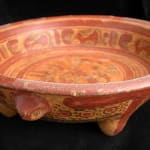Mayan Polychrome Quadrapod With Double Turtle Effigy, 300 CE - 900 CE
Terracotta
9.75 x 3
PF.5656
Further images
The interior flat center of this elevated dish is decorated by the image of a seated shaman or ruler. This man wears an elaborate plumed headdress that rises over the...
The interior flat center of this elevated dish is decorated by the image of a seated shaman or ruler. This man wears an elaborate plumed headdress that rises over the top of his head and falls in front of his face. He also has on a feathered costume over his back. The figure holds out his hands as if presenting an offering to the gods. Perhaps this vessel was used in ritualistic ceremonies. This image is encircled by a series of thin red and black rings. The interior vertical, sloping rim is filled by a band of glyphs representing a face with a long hooked nose. Although this appears to us more like an elephant, this glyph probably symbolizes the hook-nosed snake god. The most spectacular feature of this work is the two turtles that protrude from the contours of the bowl as if they were holding it up and carrying it to the gods. Their small red heads and legs gently project from the body. You can see their round black eyes and wide flat mouths. A pattern of red and black dots represents the pattern of their skin. In between the two turtles, a panel of swirling wave glyphs is painted. Discovered inside of a tomb, buried alongside a fallen ruler or dignitary, this vessel was as essential in the afterlife as it was in this world.







